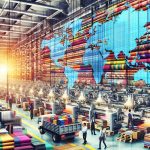While innovation drives the textile industry forward, trade policies can either propel it or hold it back. You need to account for how tariffs and duties influence your sourcing strategies, while quotas and restrictions dictate market access. Understanding these elements isn't just about compliance; it's about staying competitive. How do trade agreements shape your business decisions, and what role does the regulatory framework play? You might find that embracing sustainable practices and new technologies isn't optional but necessary for success. Let's uncover how these factors intertwine and what it means for your strategy.
Table of Contents
Key Takeaways
- Tariffs and duties significantly impact the cost and market dynamics of imported textiles.
- Trade agreements remove barriers, increasing market access and supply chain integration for textile companies.
- Quotas and restrictions on imported textiles can limit production and increase costs.
- Compliance with regulatory frameworks is essential to avoid operational disruptions in the textile industry.
- Industry innovation through advanced technologies and sustainable practices drives growth and compliance in the textile sector.
Tariffs and Duties
Tariffs and duties directly impact the cost of imported textiles, influencing both the market and consumer choices. By imposing these financial levies on imported goods, governments can make foreign textiles more expensive compared to domestic products. You'll need to conduct a thorough impact analysis to understand this dynamic fully.
When tariffs rise, the increased costs are often passed down the global supply chains, affecting every link from production to retail.
In your quest for mastery, consider how these tariffs can alter the competitive landscape. Higher tariffs might discourage imports, giving local manufacturers a competitive edge. However, they can also lead to higher costs for consumers and potentially limit the variety of available textiles.
Global supply chains are particularly sensitive to these changes. A tariff hike in one country can ripple through the entire network, causing delays, increasing costs, and disrupting the flow of goods.
To mitigate these impacts, companies often re-evaluate their sourcing strategies, sometimes opting to relocate production to countries with more favorable trade terms. By understanding the intricacies of tariffs and duties, you can better navigate the complexities of international textile trade and optimize your business strategies accordingly.
Quotas and Restrictions
Quotas and restrictions often shake up the textile industry by capping the amount of certain goods that can be imported. These import limitations can directly impact your business strategy. By restricting the quantity of textiles entering the market, they can create production constraints for manufacturers relying on imported raw materials. You must navigate these limitations to maintain operational efficiency and meet production targets.
Understanding the implications of quotas is vital for staying globally competitive. When market access restrictions are imposed, they can limit your ability to source high-quality, cost-effective materials from international suppliers. This can lead to increased production costs and, ultimately, higher prices for your end products. Adapting to these changes quickly will help you maintain a competitive edge in the global marketplace.
Moreover, quotas and restrictions can also affect your relationships with suppliers and customers. Limited import volumes might force you to diversify your supplier base or invest in local production capabilities. Both strategies require careful planning and resource allocation. By mastering these challenges, you can turn potential obstacles into opportunities for innovation and growth.
Trade Agreements
Trade agreements can significantly alter the landscape of the textile industry by removing barriers and opening up new markets. When countries enter into global partnerships, you gain access to a broader array of resources, reducing costs and increasing competitiveness. These agreements lower tariffs and other trade barriers, making it easier for you to export your products and import raw materials.
This improved market access can be a game-changer, allowing you to tap into new customer bases and diversify your revenue streams.
Beyond just market access, trade agreements also facilitate supply chain integration. By harmonizing standards and reducing bureaucratic hurdles, you can streamline your operations and improve efficiency. This is particularly important in the textile industry, where timely delivery of materials and products is vital.
The economic impacts of such agreements are substantial, often leading to increased investment and job creation in the sector.
Regulatory Frameworks
Understanding regulatory frameworks is essential for ensuring your textile business complies with both domestic and international laws. You'll need to navigate a complex landscape of compliance standards and import regulations to avoid costly penalties and maintain a competitive edge. First, familiarize yourself with the specific compliance standards relevant to your market, which can vary significantly between regions.
Next, stay updated on import regulations that affect your supply chain. These regulations often dictate the quality, safety, and labeling requirements for textile products entering a new market. Ignoring these rules can result in shipments being delayed or rejected, severely impacting your business operations.
To help you grasp the critical aspects, here's a concise table breaking down key regulatory elements:
| Aspect | Domestic Regulations | International Regulations |
|---|---|---|
| Compliance Standards | National safety and quality laws | ISO standards, regional agreements |
| Import Regulations | Customs duties, import taxes | Tariffs, trade barriers |
| Labeling Requirements | Country-specific labeling laws | Global labeling conventions |
| Environmental Impact | Local environmental policies | International sustainability guidelines |
| Enforcement Agencies | Domestic regulatory bodies | Global trade organizations |
Industry Innovation
Innovation propels the textile industry forward, making it essential for businesses to embrace new technologies and sustainable practices. You're at the forefront of transforming an industry that's ripe for change. By focusing on innovation, you can achieve efficiencies, reduce waste, and meet evolving consumer demands for eco-friendly products.
To master industry innovation, consider these key areas:
- Adopt Advanced Technologies: Utilize cutting-edge machinery and software to streamline production. Automation and AI can greatly improve quality control and operational efficiency.
- Implement Sustainable Practices: Shift towards eco-friendly materials and processes. Investing in water-saving techniques and renewable energy sources can make your operations more sustainable and cost-effective.
- Enhance Supply Chain Transparency: Leverage blockchain and IoT technologies to track materials from origin to consumer. This transparency not only builds trust but also guarantees compliance with ethical standards.
- Invest in R&D: Prioritize research and development to stay ahead of trends and create innovative products. Collaborate with academic institutions and industry leaders to foster a culture of continuous improvement.
Frequently Asked Questions
How Do Trade Policies Impact Domestic Textile Job Opportunities?
You might notice subtle changes in job opportunities due to economic impact and job displacement. Global competition and automation trends can shift the landscape, making it essential to adapt and thrive in an evolving market.
What Are the Environmental Implications of Trade Policies on the Textile Industry?
You should consider how trade policies can influence the textile industry's environmental impact. They can either reduce the carbon footprint and promote sustainability or hinder pollution control by weakening regulations, depending on their design and enforcement.
How Does Consumer Demand Influence Trade Policies in the Textile Sector?
You directly impact global supply and market trends. When your demand rises, trade policies adapt to enhance supply chains. Conversely, low demand can lead to stricter regulations, altering how products reach the market.
What Role Do Small and Medium Enterprises Play in the Textile Trade Landscape?
You're the lifeblood of the textile trade landscape. Small and medium enterprises weave the intricate supply chain, driving innovation and resilience. Your economic impact isn't just measured in dollars but in the diverse, vibrant fabric you create.
How Are Labor Rights Addressed Within the Global Textile Trade Policies?
You'll find labor rights addressed by emphasizing ethical sourcing in global policies. These policies promote safe working conditions, fair wages, and prohibit child labor, aiming to promote a responsible and sustainable textile industry.
- Why Is My Crepe Fabric Puckering? (And 4 Ways to Fix It) - June 23, 2025
- How to Hem a Crepe Dress: 3 Easy Methods for a Professional Finish - June 23, 2025
- The Best Stitches for Crepe Fabric: French Seams, Rolled Hems & More - June 23, 2025







